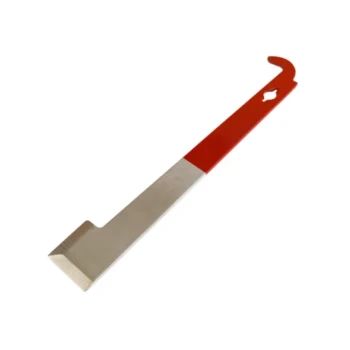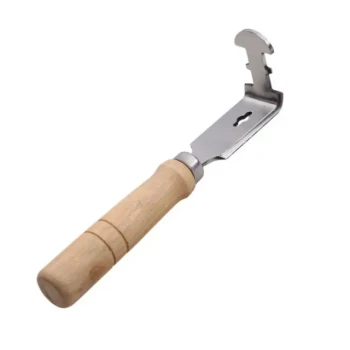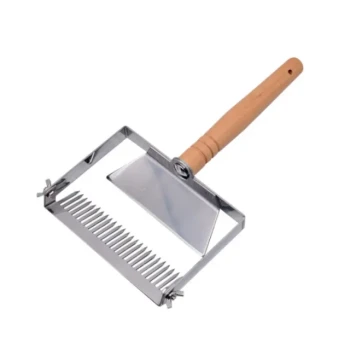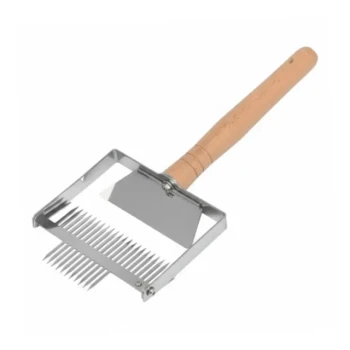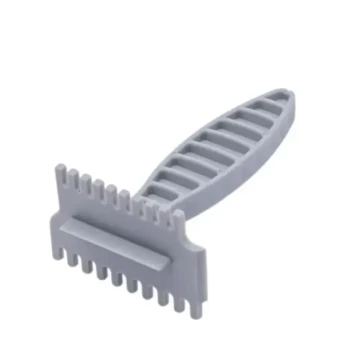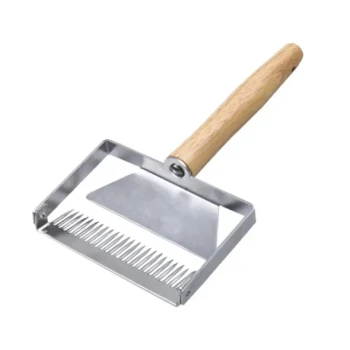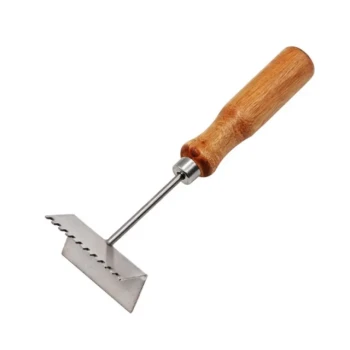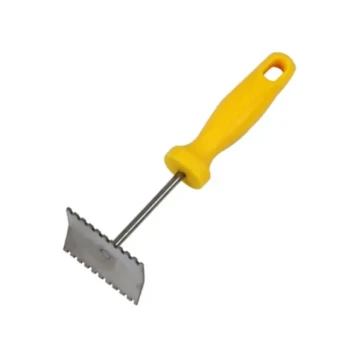Properly cleaning and sanitizing your hive tool involves a multi-step process of physical removal and chemical or thermal sterilization. First, physically scrape off all visible wax and propolis. Next, scrub the tool thoroughly with an abrasive pad and a cleaning agent to remove sticky residues. Finally, sterilize the tool using heat or a chemical soak to eliminate microscopic pathogens that can spread disease.
Your hive tool is an extension of your hands, touching every part of the hive interior. A quick scrape only removes visible debris, leaving behind microscopic disease spores. True sanitization is a critical discipline for preventing the accidental spread of devastating diseases between your colonies.
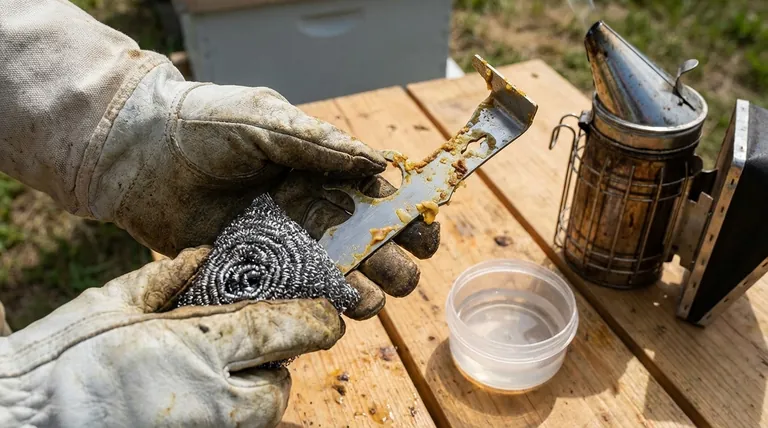
Why a Simple Scrape Isn't Enough
A hive tool is indispensable, used for prying frames, scraping propolis, and even inspecting brood. This constant contact with every hive surface makes it a primary vehicle for transferring pathogens.
The Hive Tool as a Vector for Disease
Propolis and beeswax are inherently sticky. They act like glue, trapping bacteria, fungal spores (like chalkbrood), and viral particles. When you move from one hive to another without sanitizing, you risk carrying these invisible threats with you.
Cleaning vs. Sanitizing: A Critical Distinction
These two terms are not interchangeable. Cleaning is the physical removal of visible debris like wax, honey, and propolis. Sanitizing is the process of killing microscopic organisms, such as the hardy spores of American Foulbrood (AFB), on the cleaned surface. Effective biosecurity requires both.
A Spectrum of Cleaning and Sanitizing Methods
The appropriate method depends on your situation, from a quick field cleaning to a full sterilization between apiaries.
The In-Field Scrape and Burn
For quick hygiene between frames or healthy hives in the same yard, a physical scrape is the first step. You can stab the tool into the ground a few times to help dislodge debris.
Following the scrape, placing the tool in the hot fire pot of your smoker for 10-15 seconds uses intense heat to sterilize the surface. This is a highly effective field method for killing pathogens.
The Basic Wash
This method is suitable for end-of-day cleaning when you've only worked in a single, healthy apiary.
First, scrape off all heavy buildup. Then, use a stainless-steel scrubber and a cleaning powder or baking soda with hot water to scrub away all remaining wax and propolis residue. Rinse with clean water and allow it to air dry completely.
The Chemical Soak: The Gold Standard
This is the most thorough method and should be considered mandatory when moving between different apiaries or when disease is known or suspected.
Start by performing a basic wash to remove all physical debris. After rinsing and drying, fully immerse the tool in a container of rubbing alcohol (70% isopropyl alcohol). Leave it soaking until its next use to ensure complete sanitization.
Understanding the Trade-offs
Choosing a method involves balancing speed against absolute biosecurity. Understanding the risks will inform your decision.
Speed vs. Efficacy
The scrape-and-burn method is fast and effective for field use, disrupting your workflow minimally. A full chemical soak is more time-consuming but offers the highest level of assurance that you have eliminated pathogens.
The Risk of Inadequate Sanitization
The consequences of poor tool hygiene can be catastrophic. Spreading American Foulbrood can lead to the loss of the hive and may require burning the equipment. Diseases like chalkbrood and pests like Small Hive Beetles can also be easily transferred on a dirty tool, weakening colonies and reducing productivity.
Choosing Your Sanitizing Agent
Fire is an excellent sterilizer, but it can weaken the temper of the steel over time. Rubbing alcohol is highly effective but requires the tool to be clean first, as organic debris can neutralize its effect. A simple hot water wash is only for cleaning, not sanitizing.
Matching Your Method to the Risk
There is no single "best" method; the correct choice depends entirely on the context of your work.
- If your primary focus is working within a single, healthy hive: A thorough scrape followed by a quick burn in your smoker is an effective and efficient practice.
- If your primary focus is moving between multiple hives in the same apiary: A complete wash with a scrubber and hot water after you finish for the day is a solid baseline for good hygiene.
- If your primary focus is visiting different apiaries or dealing with a suspected disease: You must use a full sterilization method, such as a chemical soak in rubbing alcohol, between every single hive, without exception.
Treating your hive tool with this level of diligence is one of the simplest and most effective investments you can make in the long-term health of your bees.
Summary Table:
| Method | Best For | Key Steps |
|---|---|---|
| Scrape & Burn | Quick field use, same healthy apiary | Scrape debris, sterilize in smoker fire pot for 10-15 sec |
| Basic Wash | End-of-day cleaning, single apiary | Scrape, scrub with abrasive pad & hot water, air dry |
| Chemical Soak | Moving between apiaries, suspected disease | Full wash, then soak in 70% isopropyl alcohol until next use |
Protect your apiary with professional-grade hygiene. A clean hive tool is your first defense against devastating diseases like American Foulbrood. At HONESTBEE, we supply commercial apiaries and beekeeping equipment distributors with durable, easy-to-clean hive tools and sterilization supplies designed for rigorous biosecurity protocols. Ensure your colonies' health—contact our wholesale team today to equip your operation with tools built for longevity and safety.
Visual Guide
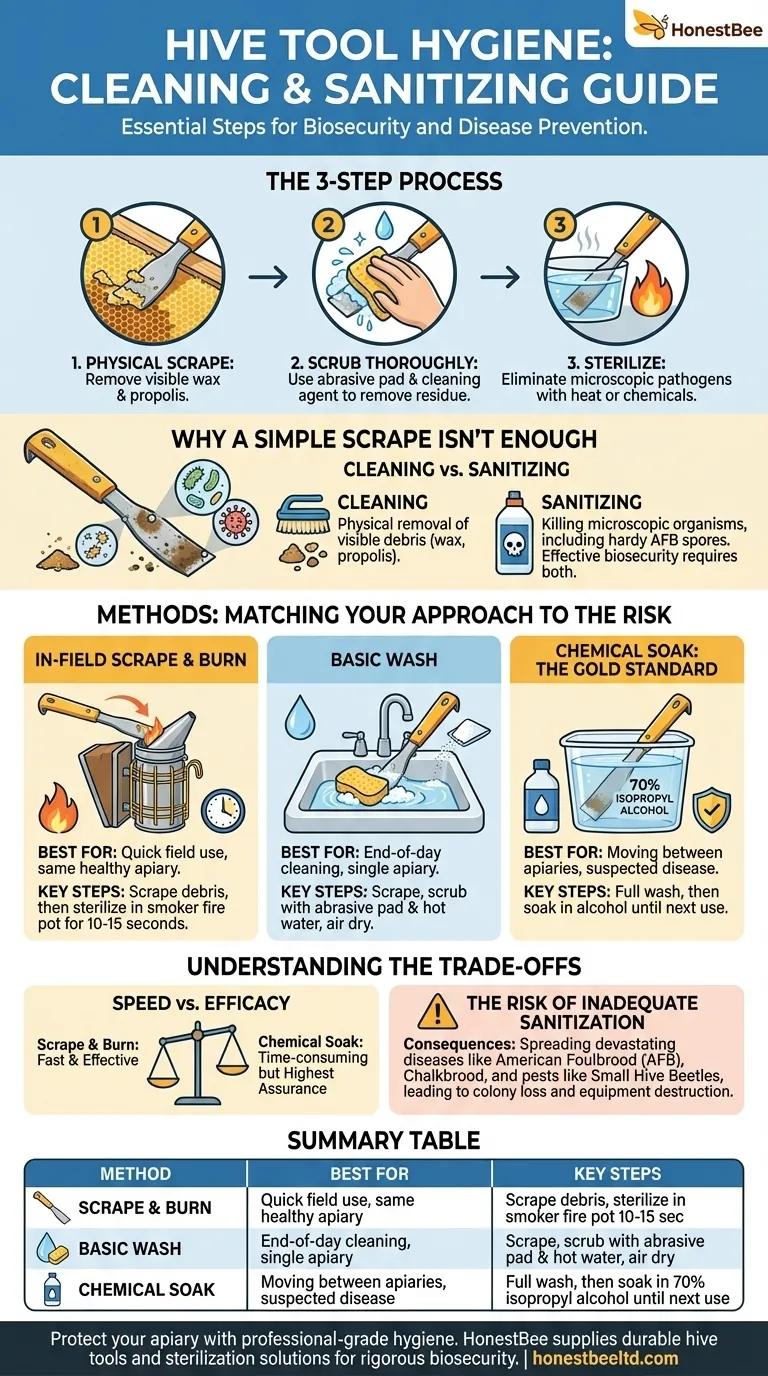
Related Products
- HONESTBEE Advanced Ergonomic Stainless Steel Hive Tool for Beekeeping
- Professional Dual-End Stainless Steel Hive Tool for Beekeeping
- Professional Stainless Steel J-Hook Hive Tool
- Professional Wide Blade Honey Scraper for Beekeeping and Honey Processing
- Professional Stainless Steel Frame Cleaner with Ergonomic Wood Handle
People Also Ask
- What are the features of a regular hive tool? The Essential Multi-Tool for Every Beekeeper
- Why is it important to compare the progress of different hives? A Beekeeper's Key Diagnostic Tool
- What is a hive tool and what are its uses? Master Your Hive Inspections with the Essential Beekeeper's Tool
- How is a hive tool used for scraping and cleaning? Master Hive Maintenance for a Healthy Colony
- Why do hive tools have a hole? Unlock the Secret to Efficient Beekeeping


